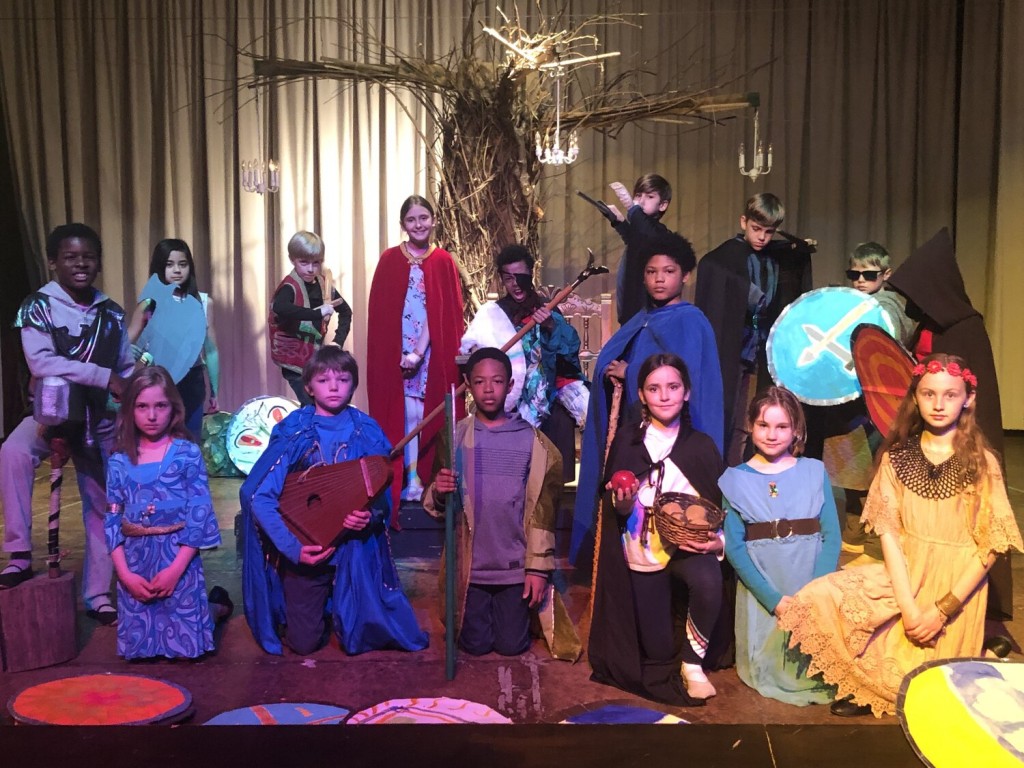
By Ben Linstrom
Every year, there is a time when each class in grades 1 through 8 stops the regular routine of main lesson blocks and immerses in preparation for a class play. It is an essential part of Waldorf education that we call pedagogical drama, because the plays specifically relate to the content of the Waldorf curriculum through the grades.

For students, this is when what they’re learning truly comes to life for them. It may be historical or cultural, and it relates to what they have been learning in the classroom during main lesson.
Routine and rhythm are important for our main lesson classes and for the children to know how their days flow. When it comes time for the class play, that routine stops and gives way for three or four weeks to have the entire class pool their talents to work on this artistic project for part of each day.
Teachers think deeply about which play will work best for their class at that time.
It begins with the class reading through the play. A number of plays have been written by Waldorf teachers that have been shared between schools and regions. There are also books on pedagogical theater, with examples of different plays from different classes.
Usually the teacher arranges or rewrites the play for their class specifically; some teachers go so far as to write their own play. This process begins with the teacher thinking about what play will suit the class when they begin summer lesson planning, looking out at the year to come.
Sometimes the revising happens because we are imagining particular students in particular roles, and we want the role perfectly suited for that child. For students who go through the whole eight years, they get a chance to be in a variety of roles over the years.
When it comes time for the class play, the teacher presents the play to the class, and the class reads through the play together. Teachers are involved with choosing which parts students will play. A lot of times the roles are specifically picked to empower the children in the class. Sometimes it’s the least expected person that you can imagine who would be in a lead role in the play. Last year, I let students write persuasive essays about which character they wanted to be.
Once the roles are identified, the students work on their lines and start to become different characters.

There are so many positive benefits of doing this kind of work. One that is crucial is how much it is dependent on teamwork, everyone relying on one another. A play is a true team effort, and it succeeds or fails on the whole of the class working in alignment – whether helping somebody get into their character or working on lines with other students or building the set together, learning the music together.
All of these essential tasks allow the class to become more cohesive. That is one reason why every class performs its annual play.
For individual students, the support from classmates while you inhabit a very independent role buoys their effort. Each individual student must memorize his or her lines, must work on speaking with clarity, gaining confidence to stand on a stage, in front of a group of people.
Another benefit of the Waldorf class play is that our graduates have a strong ability as high school students to stand in front of their class and confidently deliver a presentation. They can inhabit a character and convey a message with ease. That comes from years of working on their class plays.
On a deeper level, as the students are studying these different places and times in history, they do more than just learn about it from a book or a story. We sing songs from this place, we do crafts, we read literature, they write essays, they make their main lesson books. And then, some of the characters from the cultural and traditional stories they’re learning come to life as they enact them and embody them, profoundly deepening the learning process.
Class plays follow the themes of each grade. First grade focuses on fairy tales. In second grade, it’s saints. Third grade is the ancient Hebrews, and fourth grade focuses on local geography or Norse mythology. In fifth grade, students study ancient Greece, Egypt and India. Sixth grade is ancient Rome, seventh grade is the Renaissance, and in eighth grade, it’s all revolutions, as the children themselves step into that phase of their development.

The plays not only reflect, but truly intensify, what each year seeks to impart to students. Deep learning that they will understand and remember long after they move on to a new grade.
And, we can’t ignore the beauty of this gift that each class play gives to the rest of the school, an opportunity to encourage and applaud peers in a different grade, who are courageous enough to share their talents and their hard work with the school community.
As we work on the class play, the children ask more questions about the time periods we are studying. They eagerly read books on their own to deepen their connection with the subject matter. They embody the archetypal characters in a way that enables them to learn about human psychology, what it means to be the villain or the thief or the hero or the henchman.
Students get to know new sides of themselves, perhaps empathizing with characters in the story that they might not have connected with in other modes of learning.
And of course, there is so much more that invites their cooperation and talent. Set design, set building, lighting and music. Especially as the grades go up, the children have more and more creative vision and freedom for their plays. They can add lines or actions to more fully develop their character. They can own their roles.
Our tradition of class plays is a rich world of learning that is a beautiful part of a Waldorf education.
Ben Linstrom is the current 5th grade teacher at Detroit Waldorf School.
Republished from detroitwaldorf.org courtesy of Waldorf Today e-newsletter
